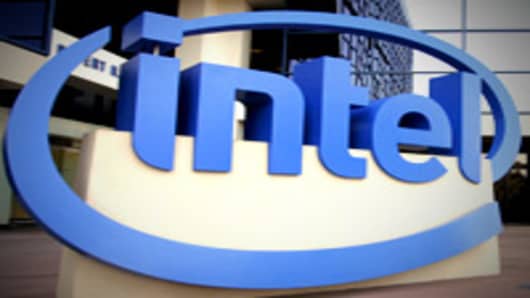Chalk one up for Intel Corp. The world's largest chipmaker is out to get bigger by getting
smaller, thanks to the release today of its new "Penryn" family of microprocessors.
These are the first to rely on a material called Hafnium, instead of the tried-and-true silicon that gave Silicon Valley its name. The new chips, more importantly, are also the first to be produced on the 45-nanometer scale and that's why Intel is generating so much buzz today.
The transistors on these chips are so small that you can cram 30 million of them onto the head of a pin; and because they're so small, and so concentrated, the conventional thinking is that Intel could shave 25-30 percent from its manufacturing costs. And lower manufacturing costs will mean higher margins.
OK, so that's the skinny on the new chips and why they're so important to the company's future. I had the chance to speak with Sean Maloney earlier this morning, Intel's executive vice president, (my interview with him is also posted here) about the importance of these chips for Intel's future.
He made no bones about how critical they are, especially since the chips take advantage of two key trends in technology: the explosion of notebook computers, and the proliferation of downloaded video, thanks to Google's YouTube, Apple's iTunes and so many other key sites.
These chips, he says, will enable high-definition video over the internet and that could very well become the net's next big killer application. "We feel we've got momentum," he tells me. "When we innovate strongly, we find that our business tends to do well, and this is a big breakthrough for us, and we're feeling really good about it."
To say the least. The 45-nanometer process is so important for the company on a variety of levels. Cutting production costs means cutting the processor's final cost as well--without having to sacrifice margins.
Chips with this kind of performance, at this price-point, will enable Intel to further explore emerging markets, where Craig Barrett, the company's chairman, has told me in the past that the web's "next billion users" will come from. Penryn gives Intel some key competitive edges over rival Advanced Micro Devices , which is out today with its own innovations.
AMD says its new chips will be create the best home-gaming PC in the world, capable of delivering real-time cinematic rendering of current generation movie-quality computer generated graphics. AMD says the new chip will deliver the raw computing power of 80 Sony PS3s and is "capable of delivering what many consider the holy grail of gaming experiences, in essence playing a movie as one would play a video game, with no degradation of quality.
I haven't had a chance to play with the AMD chip or any system based on it. So for now, Intel's Penryn will enjoy center-stage as these two rivals continue to play a multi-billion dollar game of innovation Leap Frog. "Nehalem" (a town in Oregon) comes next from Intel. This should make for a very interesting Consumer Electronics Show come January.
Questions? Comments? TechCheck@cnbc.com


